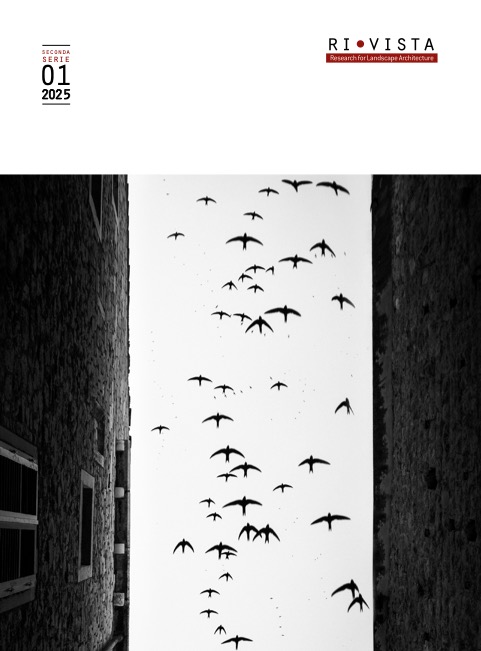Published 2025-10-28
Keywords
- Arctic Urbanism,
- Iced Sea,
- Bothnia Gulf,
- Temporary Architecture
How to Cite
Copyright (c) 2025 Stefano Tornieri

This work is licensed under a Creative Commons Attribution 4.0 International License.
Abstract
This paper explores the role of the cryosphere as a dynamic element in Arctic urban design, with a focus on its implications for public space planning in winter cities. The cryosphere, encompassing snow, sea ice, permafrost, plays a dual role in Arctic urbanism: as a temporary, accessible open space enabling unique modes of public engagement and as a fragile ecosystem under threat from climate change. Using Luleå, Sweden, as a case study, the research highlights how Arctic cities creatively utilize frozen spaces such as sea ice for recreation, transportation, and social activities. Key features like Luleå’s ice road exemplify the integration of seasonal infrastructure into urban life, offering a model for leveraging the cryosphere as “white infrastructure.” The paper further examines the challenges posed by climate change, including the shortening ice season, which threatens both the ecological stability of sea ice and its cultural and functional roles.
References
- Andersson L. 2013, Baltadapt Strategy for Adaptation to Climate Change in the Baltic Sea Region: A proposal preparing the ground for political endorsement throughout the Baltic Sea Region, Danish Meteorological Institute, Copenhagen.
- Chapman D., Nilsson K., Larsson A., Rizzo A. 2017, Climatic barriers to soft-mobility in winter: Luleå, Sweden as case study, «Sustainable Cities and Society», 35C. 574-580. DOI: https://doi.org/10.1016/j.scs.2017.09.003
- Chapman D., Nilsson K.L., Rizzo A., Larsson A. 2019, Winter City Urbanism: Enabling All Year Connectivity for Soft Mobility, «International Journal of Environmental Research and Public Health», vol. 16, no. 10, p. 1820. DOI: https://doi.org/10.3390/ijerph16101820
- Chapman D., Nilsson K.L., Sjöholm J., 2024, Planning and Urban Design for Attractive Arctic Cities (1st ed.). Routledge. DOI: https://doi.org/10.4324/9781003336136-1
- Cho L., 2020, Permafrost Politics: Toward a Relational Materiality and Design of Arctic Ground, «Landscape Research», 46(1), 25–35. DOI: https://doi.org/10.1080/01426397.2020.1831461
- Couling N., Hein C., 2021, The Urbanisation of the Sea: From Concepts and Analysis to Design, Nai010 Publishers, TU Delft.
- Designboom. Futuristic arctic saver tower sprays seawater to thicken melting ice <https://www.designboom.com/architecture/arctic-saver-tower-ice-antarctica-06-11-2019/> (03/25)
- Erskine R.,1961, The Sub-Arctic Habitat, in Newman, O. (ed.), CIAM ’59 in Otterlo: Group for the Research of Social and Visual Inter-Relationships, Alec Tiranti, London, pp. 160–168.
- Foscari G. (eds). 2021, Antarctic Resolution, Lars Müller Publishers, Zürich.
- Gällivare Kommun. 2016, Grön-, blå- och vitstrukturplan Gällivare. https://gallivare.se/download/18.4e20a890188bda337d16238c/1687718683989/GBV_slutlig_20160321.pdf
- Geilfus N.X., Munson K.M., Eronen-Rasimus E., Kaartokallio H., Lemes M., Wang F., Rysgaard S., Delille B., 2021, Landfast Sea Ice in the Bothnian Bay (Baltic Sea) as a Temporary Storage Compartment for Greenhouse Gases, «Elementa: Science of the Anthropocene», vol. 9, no. 1, p. 00028. DOI: https://doi.org/10.1525/elementa.2021.00028
- Hamelin L.E., 2000, Le Nord et l’hiver dans l’hémisphère boréal. «Cahiers de géographie du Québec», 44(121), 5–25. DOI: https://doi.org/10.7202/022879ar
- Hemmersam P., 2021, Arcticness and the Urbanism of the North, «Arctic Yearbook 2021: Defining & Mapping the Arctic: Sovereignties, Policies & Perceptions», pp. 452–468.
- Hammersam P., 2021, Making the Arctic City: The History and Future of Circumpolar Urbanism. London: Bloomsbury DOI: https://doi.org/10.5040/9781350235892
- Kontula T., Raunio A., (eds) 2019, Threatened Habitat Types in Finland 2018: Red List of Habitats. Results and Basis for Assessment, «The Finnish Environment», vol. 2, pp. 254.
- Irwin D., Project rig <https://www.youtube.com/watch?v=ayjvntxopP8> (03/25)
- Laine T., 2006, Lars von Trier, Dogville and the Hodological Space of Cinema, Studies in European Cinema, vol. 3, no. 2, pp. 129–141. DOI: https://doi.org/10.1386/seci.3.2.129_1
- Lefebvre H., 1974, The Production of Space, Blackwell, England.
- Legault O., 2018, Le design hivernal des espaces publics. Études de cas scandinaves, «Le froid. Adaptation, production, effets, représentations, sous la dir. de Chartier, Daniel et Borm, Jan» Québec, Presses de l'Université du Québec, coll. Droit au Pôle, pp. 75-88. DOI: https://doi.org/10.1515/9782760549241-006
- Leppäranta M., 2023, History and Future of Snow and Sea Ice in the Baltic Sea, Oxford Research Encyclopedia of Climate Science. Retrieved 14 November 2024, from https://oxfordre.com/climatescience/view/10.1093/acrefore/9780190228620.001.0001/acrefore-9780190228620-e-891. DOI: https://doi.org/10.1093/acrefore/9780190228620.013.891
- Lépy É., 2012, Baltic Sea Ice and Environmental and Societal Implications from the Comparative Analysis of the Bay of Bothnia and the Gulf of Riga, «Fennia», vol. 190. DOI: https://doi.org/10.11143/4403
- Ligi G., 2016, Lapponia. Antropologia e Storia di un Paesaggio, Edizioni Unicopli, Varese.
- Makeham P., 2005, Performing the City, «Theatre Research International», vol. 30, no. 2. DOI: https://doi.org/10.1017/S030788330500115X
- Mäkynen M., Karvonen J., Cheng B., Hiltunen M., Eriksson P., 2020, Operational Service for Mapping the Baltic Sea Landfast Ice Properties, «Remote Sensing», vol. 12, p. 4032. DOI: https://doi.org/10.3390/rs12244032
- Pasgaard J.C., Hemmersam P., Nielsen T., 2020, New Nordic stereotypes: In search of alternative design practices for tourism in peripheral landscapes. «Journal of Landscape Architecture», 15(3). DOI: https://doi.org/10.1080/18626033.2020.1886505
- Pressman N., 1987, Images of the North: Cultural Interpretations of Winter, «Winter Communities Series», Institute of Urban Studies, University of Winnipeg. https://winnspace.uwinnipeg.ca/bitstream/handle/10680/969/154-1987-Pressman-ImagesoftheNorth-WEB.pdf?sequence=1&isAllowed=y.
- Ronkainen I., Lehtiranta J., Lensu M., Rinne E., Haapala J. Haas C., 2018, Interannual Sea Ice Thickness Variability in the Bay of Bothnia, «The Cryosphere», vol. 12, pp. 3459–3476. DOI: https://doi.org/10.5194/tc-12-3459-2018
- Sagrelius P., Lundy L., Blecken G., Rizzo A., Viklander M., 2022, Blue-Green Infrastructure for All Seasons: The Need for Multicolored Thinking. «Journal of Sustainable Water in the Built Environment».
- Sheppard L., White M., 2021, Many Norths. Spatial Practice in a Polar Territory. Actar D. Barcelona.
- Sörlin S. , 2015, Cryo-History: Narratives of Ice and the Emerging Arctic Humanities, in Dodds, K., Nuttall, M. & Heffernan, M. (eds), The New Arctic, Springer, Cham, pp. 327–339. DOI: https://doi.org/10.1007/978-3-319-17602-4_24
- Tornieri S., Ma J., Rizzo A., 2024, Which Urban and Landscape Qualities Make Arctic Villages Attractive? The Torne River Villages in Sweden, «European Planning Studies», pp. 1–21. DOI: https://doi.org/10.1080/09654313.2024.2349753
- Vihma T., Haapala J., 2009, Geophysics of Sea Ice in the Baltic Sea: A Review, «Progress in Oceanography», vol. 80, no. 3, pp. 129–148. DOI: https://doi.org/10.1016/j.pocean.2009.02.002
- Kalemeneva E., 2018, Arctic Modernism: New Urbanisation Models for the Soviet Far North in the 1960s. DOI: https://doi.org/10.1007/978-3-319-91617-0_10





